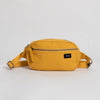We rarely consider what becomes of our garments once we've tossed them. When certain clothing items no longer make us happy, we send them off to donation centers or throw them away. Granted, we do so with the best intentions that someone may benefit from them, and while that does stand true to a certain point, the reality is there is no audience to incentivize the vast amounts of used, poor-quality clothing we discard. Our well-intentioned efforts turn into expensive waste that overwhelms the ecosystem and causes serious social and health problems for individuals living halfway across the world. For example, dune fields layered with piles of fast fashion clothing are exacerbating tragedies rapidly in Chile's Atacama Desert.
Today, an average person purchases 60% more apparel than they did 15 years ago, yet they keep each item for just half as long. Waste from textile production totals 92 million tons annually (out of the 100 billion garments), all of which winds up in landfills. A garbage truck's worth of textiles is incinerated or landfilled worldwide every second. Fast fashion has a sneaky way of discharging its textile waste by exporting outdated and unsold clothing to countries that lack the facilities to dispose of it, forcing them to bear the repercussions by default. Parts of Ghana have become toxic landfills because of fast fashion. Every week, Accra, the capital of Ghana is burdened with 7.5 million pounds of donated clothing which contaminates the beaches and neighborhoods nearby. The excessive clothes dump has resulted in textile trash accumulation along the riverbanks in Kenya and Tanzania, polluting the waterways on a high scale.
Closer look at Atacama Desert (Chile)
The Atacama Desert, an odd location for fast fashion waste, has been on spotlight as one of the dumping grounds for unwanted clothes. The relationship between fast fashion and the remote region, which is 1,000 miles to the south of Chile's major cities, is due to Chile's proximity to one of South America's top duty-free ports. Situated in the coastal city on the western side of the desert, the port was built at Iquique in 1975 to boost the struggling local economy. Eventually, Chile became one of the biggest importers of used clothing worldwide. Every year, tons of clothing are imported from Europe, Asia, and the Americas. Chilean customs data show that the total import in 2022 was 44 million tons. Rejected import items are sent off a few miles to the outskirts of Alto Hospicio for resale in local shops and open-air markets. What isn't sold at the market heads off to the desert, where it sits indefinitely and pollutes the local communities' surroundings and health.
Closing Thoughts
The horrifying images of vast volumes of textile waste poisoning the environment make it abundantly evident that global fashion companies cannot solely concentrate on improving their internal networks. The aftermath makes one rethink the problem of fast-fashion textile pollution. It is an environmental and global public health issue that can only be resolved by concerted, multidisciplinary efforts to bring about substantive political and practical action improvements. The present situation of the world's largest fog desert acts as a warning and eye-opener. It is no longer about baby steps but rather substantial changes. When it comes to transforming textile production and design, time is of the essence. The high cost to the planet just for a trendy new outfit needs immediate attention on a large scale for the sake of the people, the planet, and the greater good.
Here at Terra Thread, we are committed to reducing our environmental impact. We solely use organic cotton on our products- certified organic cotton is a sustainable alternative to conventional cotton that requires less water, pesticides, and chemicals. Terra Thread's products are also made with fair labor practices, ensuring that workers are treated ethically and paid fairly. Our products are not only durable and high-quality but also stylish, making it easy for consumers to look good while making a positive impact on the environment.
Related blog posts:





